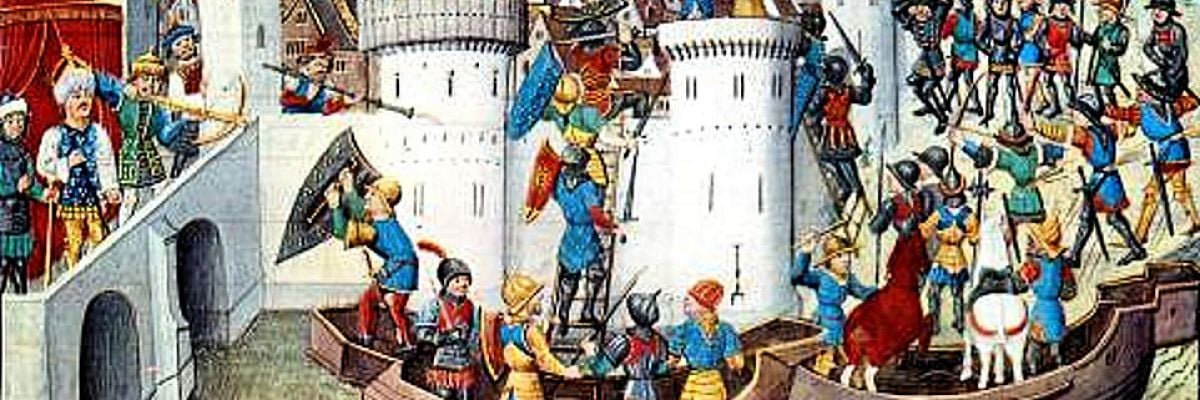
810 years ago this week, on April 13, 1204, an unthinkable act occurred: Christian armies sacked Constantinople, in what became known as the Fourth Crusade. The Crusades are among the most misunderstood events in Catholic history, and the Fourth Crusade is frequently cited by critics of the Crusades and the Church in an attempt to discredit both.
The notoriety of the Fourth Crusade comes from its (originally) unintended conquest of Constantinople, in which Christians fought Christians—to the horror of Pope Innocent III and to the scandal of modern-day Catholics. The story of how the Fourth Crusade came to Constantinople, beginning with great promise but ending in abject disaster, is one of the most intriguing in the entire history of the Crusades.
Pope Innocent III called for a new Crusade on August 15, 1198. French barons met to formulate plans for the Crusade and decided to travel to the Holy Land by sea. In order to secure their transportation, the barons sent six ambassadors to Venice to negotiate with the doge, Enrico Dandolo. Venice was eager to supply the ships, especially since the Crusaders promised the arrival of an immense army of over 30,000 men.
Today it is hard to fathom that the calculation of a number could be the cause of a Crusade gone awry, yet therein lies the truth of why the Fourth Crusade went so horribly wrong.
The ambassadors based their estimate on potential Crusaders, not those who had already taken the Cross. Thus they grossly overestimated, and only 13,000 warriors made their way to Venice by the deadline. The agreement with the Venetians called for the Crusaders to pay an amount based on the estimated number of warriors; when less showed, it placed the Crusade in jeopardy, since the Crusaders could not pay for their transportation. This was a problem for Venice as well, which was faced with a severe financial disaster if the Crusaders did not pay their debt.
Forgiving the debt was out of the question, so Dandolo proposed the Crusaders help the Venetians conquer the Croatian city of Zara (previously under Venetian control). Dandolo’s offer proved problematic, as Zara was controlled by King Emeric of Hungary, who had previously taken the Cross; therefore, his lands were protected by the Church, and attacking a Crusader’s land resulted in excommunication.
The Crusaders were thus faced with a serious moral quandary. They did not have the money to pay the Venetians, but the Venetian plan to keep the Crusade from crumbling threatened their souls. Debate raged among the Crusaders about their choices; eventually most decided to accept Dandolo’s offer.
When news of the Crusade’s diversion reached Pope Innocent III, he sent a letter to the leaders forbidding them from attacking Zara; they ignored the letter and hid it from the rank and file. As the Crusaders besieged the city, its inhabitants lowered banners with crosses over the walls to remind them they were attacking fellow Christians. The tactic did not work, and eventually the Zarans sued for peace. When news of the fall of Zara reached the pope, he wrote another letter to the Crusade’s leaders, excommunicating them.
As they wintered over in Zara, the Crusaders were approached by envoys from an exiled Byzantine prince with a truly remarkable offer. The envoys told the Crusaders that Prince Alexius Angelus needed their help to free his deposed and imprisoned father, Emperor Isaac II, and return his family to power. In return, Alexius promised, among other things, to pay the Crusaders 200,000 silver marks, enough to pay off the Venetian debt with a surplus to finance the campaign to the Holy Land. Pope Innocent III soon got wind that Crusaders were thinking of going to Constantinople, so he wrote another letter, warning them against such action. Once again, his protestations were ignored.
The Crusaders traveled to Constantinople and were shocked to learn the inhabitants were not interested in opening the city to Alexius Angelus, so they besieged the city, causing the usurper Alexius III to flee. The young prince became co-emperor (Alexius IV) with his released father and tried to fulfill his promises to the Crusaders. But he was unable to produce all the promised money, despite the extreme measures of confiscating sacred icons and vessels and stripping dead emperors of their rich vestments. Before long, Alexius IV’s affiliation with the Western warriors proved unpopular, and eventually he was imprisoned by his chamberlain, Alexius Ducas (nicknamed Mourtzouphlus), who declared himself emperor (Alexius V).
Alexius V played tough with the Crusaders and ultimately ordered the murder of Alexius IV. Unable to finance their journey from Constantinople to Jerusalem and faced with the murder of Alexius, who owed them money, the Crusade’s leaders decided to attack Constantinople a second time—which they did, brutally.
The sack of Constantinople in 1204 remains one of the enduring memories of the Crusades. It is often used to further the falsehood that the Crusades were primarily “land-grabs” or motivated by greed and desire for booty. Despite the clear papal protestations at the time, blame is still placed inappropriately with the Church for these tragic events.
Yet the Fourth Crusade was not motivated by greed. Neither was it part of some Roman plot against the East. The Crusaders desired to campaign in the Holy Land with the ultimate goal of liberating Jerusalem. It was a series of bad decisions, overzealous calculations, and historical accidents that knocked the Crusade off course and resulted instead in an attack upon fellow Christians in the Queen of Cities.
If you want to learn more about the Crusades, check out my audio set, The Real Story of the Crusades, available now from Catholic Answers Press.



